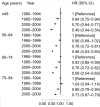Disparities of age-based cancer-specific survival improvement with various clinicopathologic characteristics for kidney cancer
- PMID: 30100757
- PMCID: PMC6067795
- DOI: 10.2147/CMAR.S169192
Disparities of age-based cancer-specific survival improvement with various clinicopathologic characteristics for kidney cancer
Abstract
Introduction: Whether or not age is a predictor of kidney cancer survival is currently unknown but debated. It is also unknown whether improved kidney cancer survival is associated with age with particular clinicopathologic characteristics. The aim of this study was to evaluate kidney cancer survival in four age-based subgroups of patients by analyzing the Surveillance, Epidemiology, and End Results-registered database.
Methods: Age-based survival disparity by sex, race, marital status, year of diagnosis, pathological grade, histological type, and stage was measured. The impact of age and further parameters on disease specific mortality was evaluated by multivariate Cox proportional hazards regression analyses.
Results: Results showed that 8-year cancer-specific survival was 79.6% in those aged ≤49 years, 70.6% in those aged 50-64 years, 65.3% in those aged 65-74 years, and 56.0% in those aged 75-84 years. These differences were significant as judged by a univariate log-rank test (P<0.001) and multivariate Cox regression (P<0.001). Age-based survival improvement was most obvious in patients diagnosed from 2005 to 2009 and with the following clinicopathologic characteristics: female, white race, low pathological grade, and localized stage. There was no obvious disparity of age-based survival improvement with regard to marital status or histologic type. No age-based survival improvement was observed in patients of the black race, pathological grade IV, or distant stage (P=0.05, P=0.07, and P=0.07, respectively).
Conclusion: These data suggest that age is an independent prognostic factor for survival in patients with kidney cancer and that age-based survival improvement is associated with particular clinicopathologic characteristics.
Keywords: SEER; age groups; epidemiology; prognosis; renal tumor.
Conflict of interest statement
Disclosure The authors report no conflicts of interest in this work.
Figures






Similar articles
-
Increasing age predicts poor cervical cancer prognosis with subsequent effect on treatment and overall survival.Brachytherapy. 2019 Jan-Feb;18(1):29-37. doi: 10.1016/j.brachy.2018.08.016. Epub 2018 Oct 22. Brachytherapy. 2019. PMID: 30361045 Free PMC article.
-
Prognostic nomograms and Aggtrmmns scoring system for predicting overall survival and cancer-specific survival of patients with kidney cancer.Cancer Med. 2020 Apr;9(8):2710-2722. doi: 10.1002/cam4.2916. Epub 2020 Feb 22. Cancer Med. 2020. PMID: 32087609 Free PMC article.
-
Regional Lymph Node Involvement Is Associated With Poorer Survivorship in Patients With Chondrosarcoma: A SEER Analysis.Clin Orthop Relat Res. 2019 Nov;477(11):2508-2518. doi: 10.1097/CORR.0000000000000846. Clin Orthop Relat Res. 2019. PMID: 31283732 Free PMC article.
-
FIGO stage, histology, histologic grade, age and race as prognostic factors in determining survival for cancers of the female gynecological system: an analysis of 1973-87 SEER cases of cancers of the endometrium, cervix, ovary, vulva, and vagina.Semin Surg Oncol. 1994 Jan-Feb;10(1):31-46. doi: 10.1002/ssu.2980100107. Semin Surg Oncol. 1994. PMID: 8115784 Review.
-
20-Year Comparative Survival and Mortality of Cancer of the Stomach by Age, Sex, Race, Stage, Grade, Cohort Entry Time-Period, Disease Duration & Selected ICD-O-3 Oncologic Phenotypes: A Systematic Review of 157,258 Cases for Diagnosis Years 1973-2014: (SEER*Stat 8.3.4).J Insur Med. 2019;48(1):5-23. doi: 10.17849/insm-48-1-1-19.1. Epub 2019 Oct 14. J Insur Med. 2019. PMID: 31609640
Cited by
-
Patient, provider, and hospital factors associated with oral anti-neoplastic agent initiation and adherence in older patients with metastatic renal cell carcinoma.J Geriatr Oncol. 2022 Jun;13(5):614-623. doi: 10.1016/j.jgo.2022.01.008. Epub 2022 Feb 4. J Geriatr Oncol. 2022. PMID: 35125336 Free PMC article.
-
53 years old is a reasonable cut-off value to define young and old patients in clear cell renal cell carcinoma: a study based on TCGA and SEER database.BMC Cancer. 2021 May 29;21(1):638. doi: 10.1186/s12885-021-08376-5. BMC Cancer. 2021. PMID: 34051738 Free PMC article.
-
Pinin acts as a poor prognostic indicator for renal cell carcinoma by reducing apoptosis and promoting cell migration and invasion.J Cell Mol Med. 2021 May;25(9):4340-4348. doi: 10.1111/jcmm.16495. Epub 2021 Apr 3. J Cell Mol Med. 2021. PMID: 33811436 Free PMC article.
References
-
- Siegel RL, Miller KD, Jemal A. Cancer statistics, 2018. CA Cancer J Clin. 2018;68(1):7–30. - PubMed
-
- Moch H, Gasser T, Amin MB, Torhorst J, Sauter G, Mihatsch MJ. Prognostic utility of the recently recommended histologic classification and revised TNM staging system of renal cell carcinoma: a Swiss experience with 588 tumors. Cancer. 2000;89(3):604–614. - PubMed
-
- Leibovich BC, Lohse CM, Crispen PL, et al. Histological subtype is an independent predictor of outcome for patients with renal cell carcinoma. J Urol. 2010;183(4):1309–1316. - PubMed
-
- Chung M, Chang HR, Bland KI, Wanebo HJ. Younger women with breast carcinoma have a poorer prognosis than older women. Cancer. 1996;77(1):97–103. - PubMed
-
- Haymart MR. Understanding the relationship between age and thyroid cancer. Oncologist. 2009;14(3):216–221. - PubMed
LinkOut - more resources
Full Text Sources
Other Literature Sources

